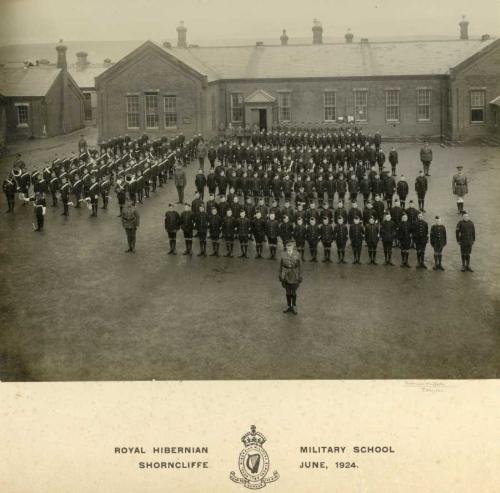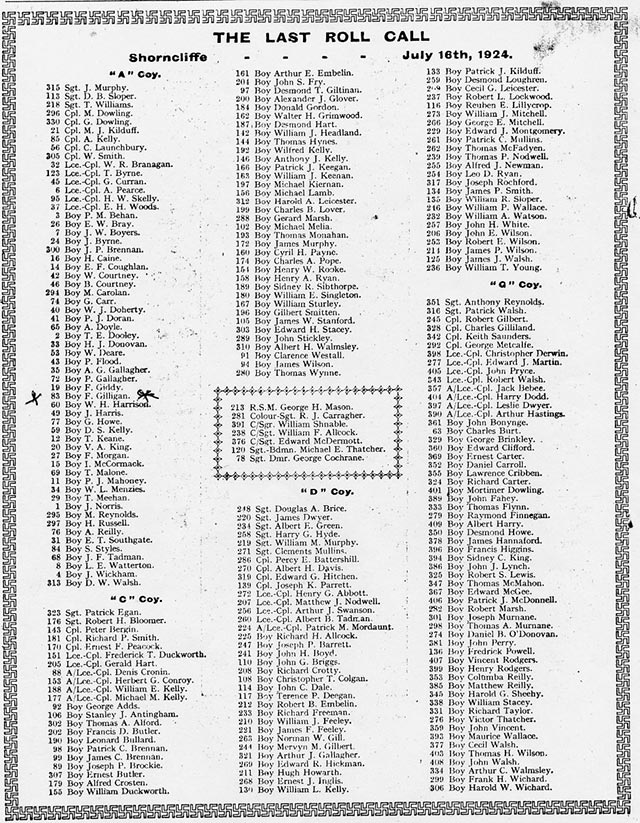The generosity of Major John D. Harris of Stalbridge, Dorset, is acknowledged for making available this historic photograph of the last muster parade of the Royal Hibernian Military School [RHMS] (1769-1724). The image was taken in 1924 at Shorncliffe Barracks, Kent. John Harris' grandfather, Major S. W. Harris, MBE, of the Royal Irish Regiment, was the last adjutant of the Hibernian School. Adjutant Harris organised the move of the school, its equipment, staff and students from Phoenix Park, Dublin, in 1922 to the school's final quarters in Kent.
|
In the photograph, four companies are to be seen on parade along with the combined band of seventy-five musicians and its drum major; the school's military staff; and three ministers of the Royal Army Chaplains' Department, irreverently known to the boys as the God squad. Comparing some known faces of boys whose names appear on the last roll call with those in the photograph, it can be affirmed that the companies in the parade follow the same order from front to rear to read A, C, D and G companies as they are listed in extant roll call. The roll call, dated 16 July 1924, shows an even distribution of students in the four companies: A Coy - 59; C Coy - 59; D Coy - 58; G Coy - 58; and HQ - 6 for a total of 240 students. A number of these about whom articles had appeared on the Hibernian School history site have been clearly identified in the photograph. The names of those present on the last parade are listed below and can be related to the companies shown on parade. |
A large number of RHMS documents and records were destroyed in the London blitz of 1940. However, thanks to the research of Mr. Howard Clarke MA, a history of the Hibernian institution may soon be available.
The Hibernian School had a long history and association with Dublin, but particularly with the village of Chapelizod from which community many of its non-military employees were drawn: cleaners, kitchen workers, nurses, grounds men, and dairy workers. Some of the civilian staff accompanied the move to Kent in 1922.
In 1769, a petition on behalf of the Hibernian Society in Dublin to the King by the Archbishop of Dublin, the Lord Chancellor and diverse nobility stated:
"That on the death of non-commissioned officers and private men in the army of the said kingdom, and upon the removal of regiments, and of drafts from regiments to foreign services, great numbers of children had been destitute of all means of subsistence; that a subscription had been set on foot in the year 1764 for raising a fund to support the establishment of a hospital in order to preserve children left in such circumstances from popery, beggary and idleness..."
The charter from the King empowered the petitioners to;
"purchase, receive and enjoy in perpetuity lands, tenements etc., not exceeding £2,000 per annum; to receive donations; and therewith to erect, maintain and support in all places in said kingdom, where they judge most necessary and convenient as they should think proper."
It is worth noting that negotiations were underway in 1921 to relocated the School in Northern Ireland. The expense of doing so, however, was beyond the finances of the British government of the day as a result of which the school, as is now known, was moved to Shorncliffe, Kent.
It having been decided not to accept more boys, the RHMS amalgamated in 1924 with the Duke of York's Royal Military School, Dover, a few miles from Shorncliffe. Natural attrition made demise of the school inevitable.
The last Hibernian student to leave the School was Boy Cecil Vincent Walsh (1912-1989) of G Coy who volunteered for the King's Shropshire Light Infantry (KSLI) in August 1931 at age 19. Walsh transferred from the KSLI to the Army Educational Corps in 1937 with the rank of Warrant Officer Class and commissioned a second lieutenant in the Intelligence Corps. Transferred to the Corps of Royal Signals with the rank of lieutenant in 1942, Walsh served throughout the Second World War in a Royal Signals Cypher unit. Promoted to captain in 1947, a major in 1953, promoted to lieutenant colonel and, in the 1967 New Years' Honours List, awarded an OBE. He died in retirement on the Isle of Wight in 1989 at age 77.
Walsh's death was prophetic because the Hibernian School inspired Major-General George Hewitt to start an infant orphanage for children of the Royal Inniskilling Fusiliers (27th Foot) at Noke's Farm on the northern boundary of Parkhurst Forest on the Isle of Wight.
Evidence has recently come to light that the Board of Governors of the School and the War Office toyed with the idea of relocating the Hibernian School in Northern Ireland, which comprised a number of counties that would remain part of the United Kingdom. This evidence will be discussed in an article on the final era of a comprehensive of the Hibernia Society and school now being written. The decision, however, was taken not to find new premises for the School, but to evacuate the boys remaining in school to Shorncliffe. The Hibernian School operated as an institution separate from the Duke of York's School until 1924 when it was amalgamated.
Note: The border of swastikas adorning the 'last roll call' document reproduced above will not go unnoticed. It is, however, pointed out that the swastika is an ancient symbol that has been in use for well over 3,000 years with a lineage at least equal to the Egyptian Ankh. Pottery and coins unearthed at Troy are proof that the swastika has been in common use since 1,000 BC: in China as the wan, Greece as the tetraskeion, German as the hakenkreuz, and Britain as the fylfot. The swastika symbol name adopted by the National Socialist Party of the Third Reich is of Sanskrit origin: swastika from 'su', meaning 'good', and 'asti' meaning 'to be' while the 'ka' is a suffix. Its use as a border for the last roll call of the Hibernians, or course, predates the rise of the National Socialist Party of Germany.
A version of this article appeared in
The Irish Sword
Vol XXV1: Summer 2008: No 103
|




